Library Hub
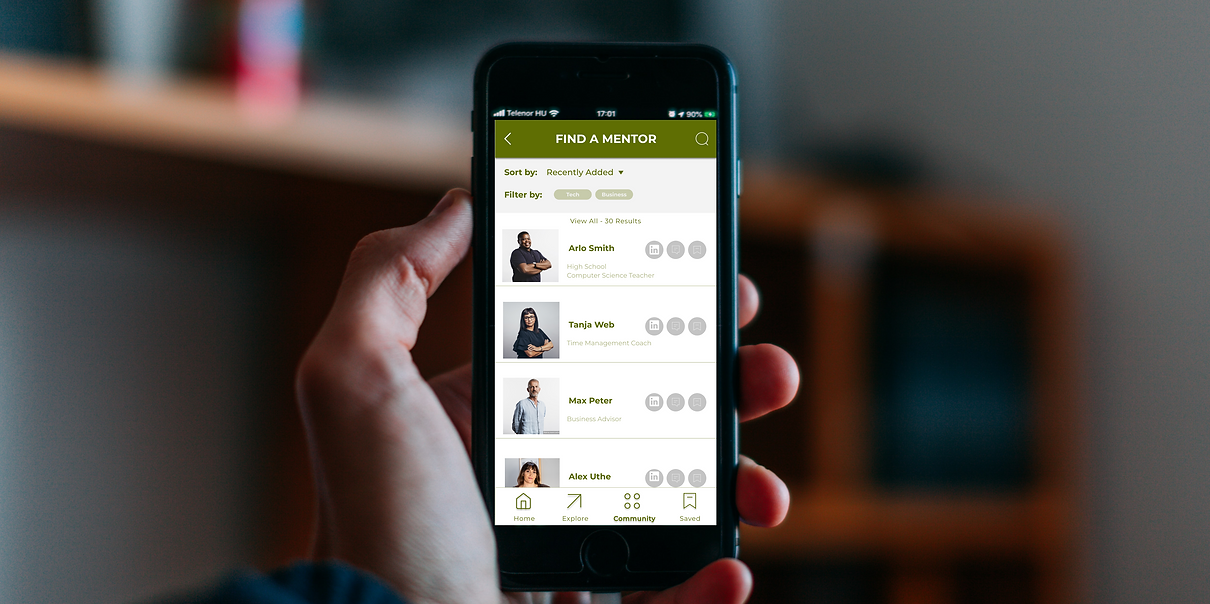
The Client
Public libraries in the United States.
Project Goal
The project seeks to strengthen the relationship between public libraries and their communities by creating a product to help library patrons get prepared for the job market of the future.
Target Audience
Young adults 22-35, that are looking to change careers or learn a new skill.
The Solution
Designing an app that can act as a learning companion for upskilling professionals with the power of the library's free resources.
My Role
UX Designer, UX Researcher
Project
Team Project
Timeline
6 Weeks
Tools
Figma, Miro, OptimalWorkshop,
Google Form, Trello
Problem Statement
An ambitious professional needs to learn new skills—technology is rapidly changing their job description—but they don’t know what their library has to offer as a community hub.
Understanding the Problem Through Research

3
SME Interviews

1
Online Survey

10
User Interviews
What Subject Matter Experts have to say
“Libraries are one of the last places you can go and you don’t have to justify being there. You don’t have to pay to be there, you don’t have to do anything, you don’t have to buy anything. It’s an inclusive space, and I wish people knew that they can do that”
-Daren, Librarian at Denver Public Library (Subject Matter Expert Interview)
Main survey finding out of 155 responses:
-
75% of users feel hindered by the cost of reskilling
-
59% of users feel the library does not help them reskill
-
93% of users have never asked for a librarian’s help when reskilling
What the Upskilling Professional Have to Say
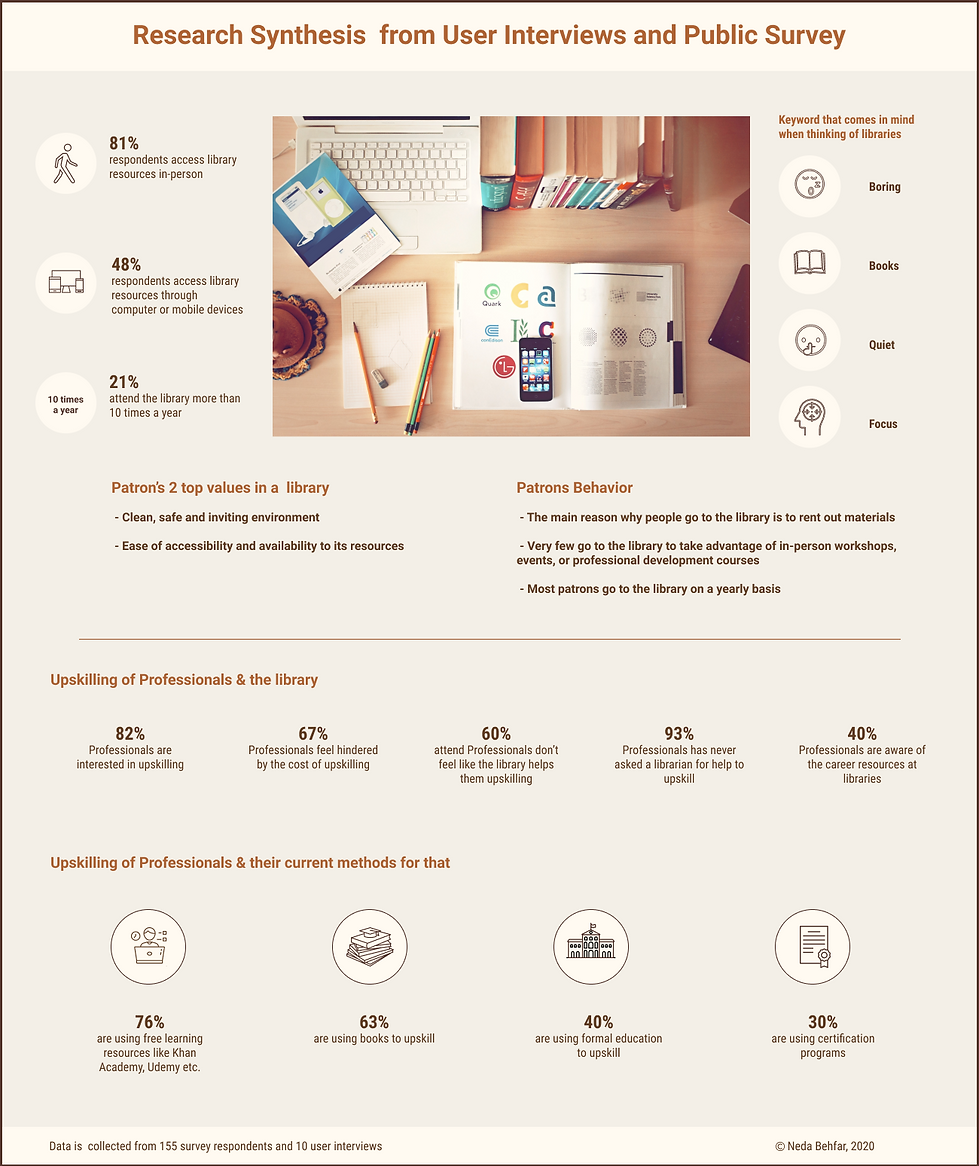
Some insights:
-
The Library resources are under used
-
Libraries are empowered by technology rather than hindered by it
-
Librarians are Tech-Savvy now a days
-
What I also found is that people like the simplicity, financial attractiveness, and the fun and engaging way to “learn at their own pace” hinging on video as a learning medium rather than e-books. Online platforms are helpful in developing technical skills like coding, design, or engineering.
What the Competitors Are Doing
To understand the niche market I did research into the library’s competitors.
Online learning has increased significantly due to the influence of the internet. I looked at direct competitors like Udemy, LinkedIn Learning (Lynda), and Boopsies for Libraries to see what they are doing. I could also learn a thing or two by looking at indirect competitors like Boys and Girls Club, YouTube, and Khan Academy.

Gaps
-
Little to no support in form of mentorship.
-
Little to no sense of belonging or community feeling.
Opportunities
-
This leaves me to wonder the impact and importance that teachers or coaches have on professional development.
-
The product I design needs to be the most convenient and free to maintain the level of accessibility that the library provides.
-
Opportunities for community building is something the library does really when they offer in-person programs or workshops. Now how might we creating this community online?
Meet Charlotte
I met Charlotte, a 29 year-old self-iterator.
As a sum of the responses and insights I learned, I created Charlotte's persona as a way for me to empathize myself with the product or service I am designing for.
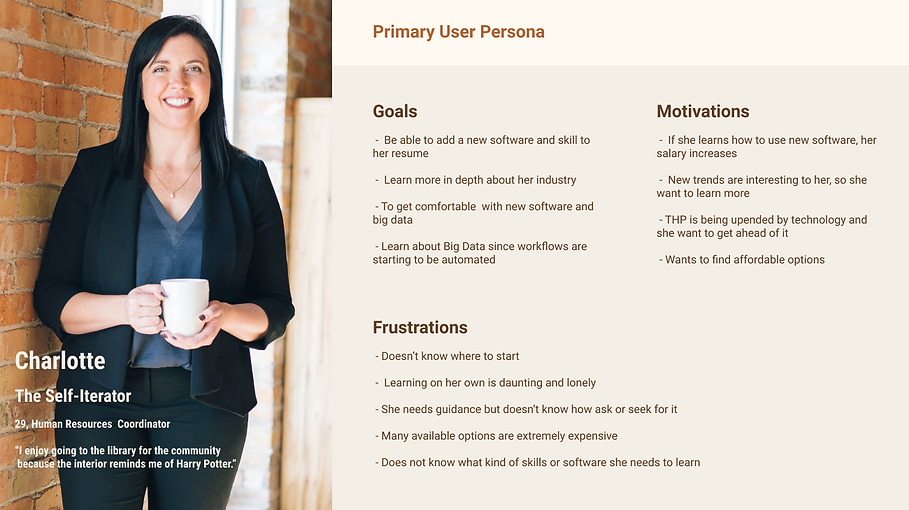
Ideating
A creative exploration allowed us to create a road map for our design.
We focused our ideation on providing patrons support in:
-
Finding learning resources
-
Getting connected to the community
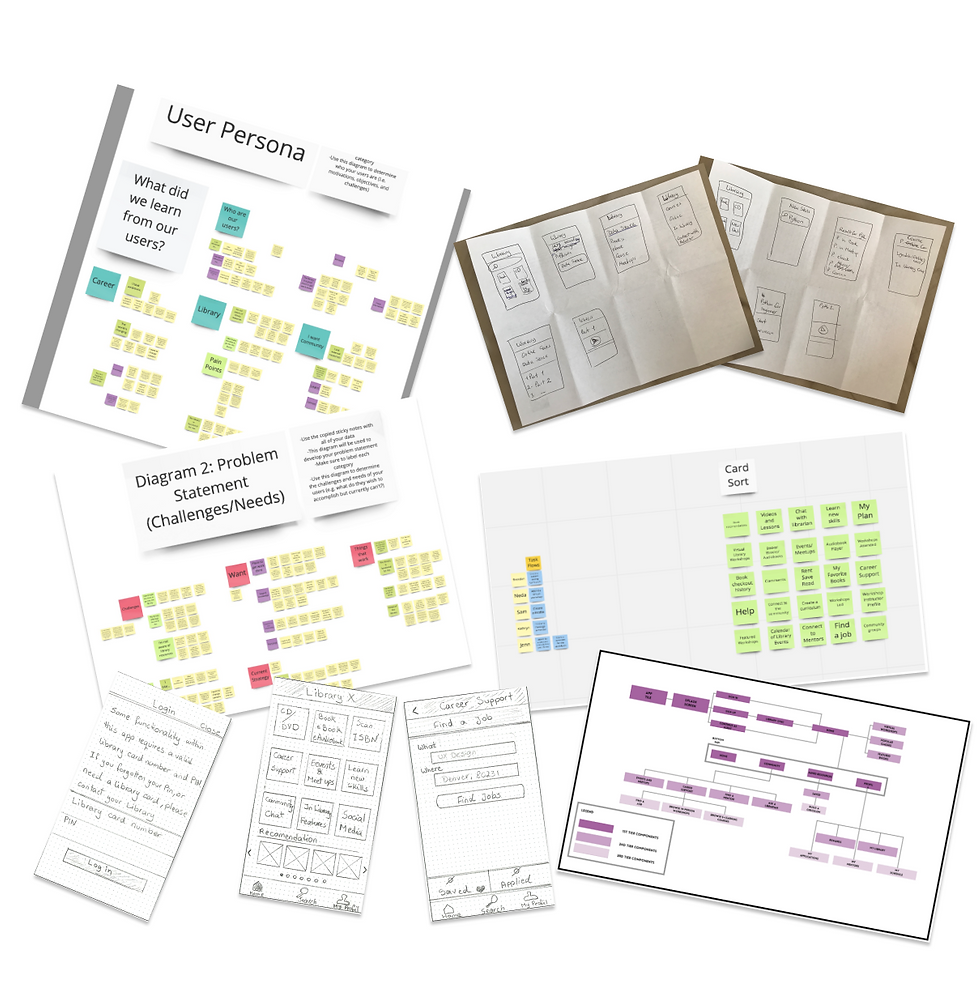
In order to uncovers how our target audience’s domain knowledge is structured, and to create an information architecture that matches users’ expectations we conducted an open card sort and created our site maps out of the findings.
Link to the cart sorting report and the site map
Usability Testing
We brought our ideations into a low-fidelity prototype to be get able to envision what the solution would look like.
The 3 core functions were:
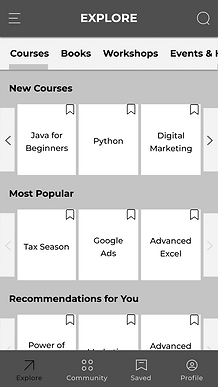

.png)
Iterate until it Feels Right
In the beginning, my team and I were trying so hard to force fit different features in our app. Our team concluded this project with 4 rounds of iterations. I learned the importance of simplifying, simplifying, simplifying and refine.
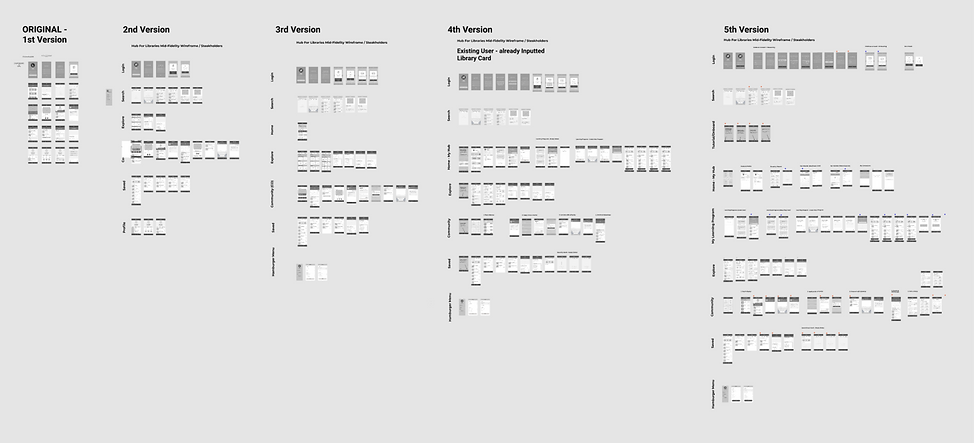.png)
Shifting gears last minute
We saw at this point that we were going down the path of designing a "catalog" of library resources when our users didn't tell us that this is their top priority or need! If we are trying to solve Charlotte's problem how do we best meet her where she is at? We recognized that we neglected our user persona we created.
So the question was now, how do people upskill?
Actually there was no right or wrong way to upskill.
-
Some people need a guided approach like certification.
-
Some people micro-learn in short periods.
-
Some people need peer support groups for accountability.
The underlying similarity among these methods is to have a goal and a way to keep track of the goal.
The Final Design
Choosing how learning the best
Preferred learning styles vary from user to user that led us to add a new feature on our onboarding, to tailor our content to meet user's needs and their learning habits.
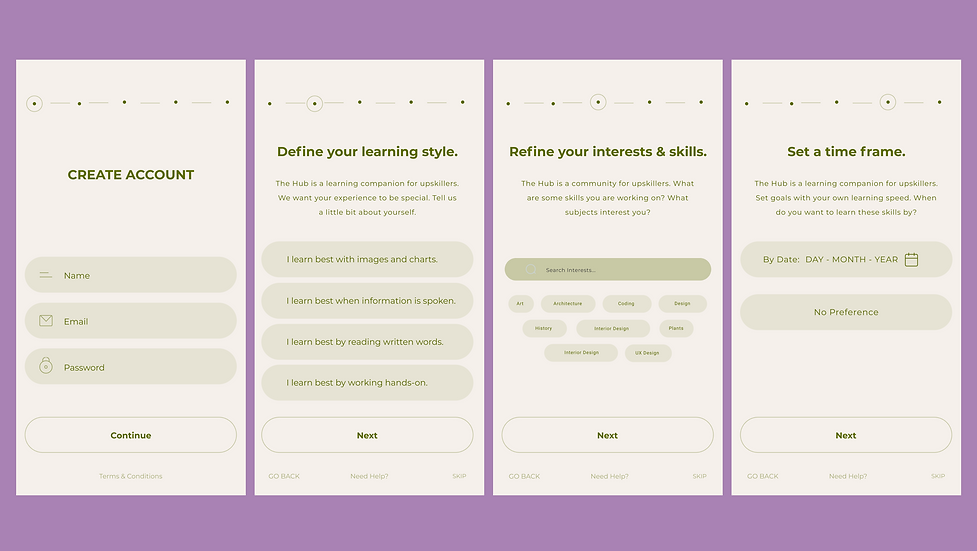.png)
Exploring what the library has to offer
Survey and usability test showed us that users find a high value in free resources and the "browsability" of an app. The
Library Hub’s Explore page emphasizes popular and new resources to encourage unified browsing by having the user feel a part of what is new and popular.
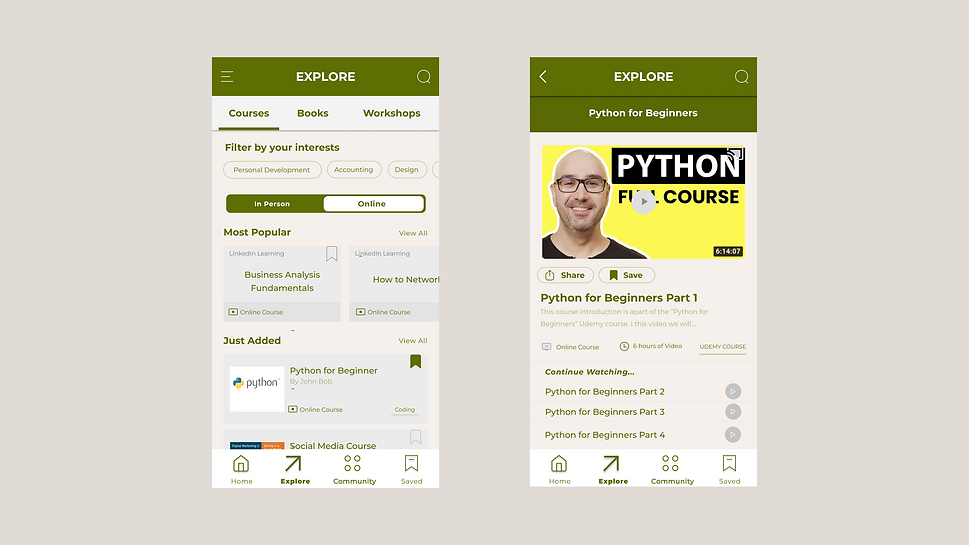.png)
Saving for later
Browsing through library shelves is a common pass-time. The "save" function is crucial to a library because it allows users to pursue their desired resource at their own pace.
.png)
Getting Support from the community
We know the library is a unifying space among learners. Our feedback tells us that the collective working environment of the library is motivating. We dedicated a portion of The Hub app to peer groups, mentorship, and leadership opportunities not only as a supportive resource, but to find community with other like-minded learners.
.png)
Personalized Learning Journey
Having an accountability partner increases the chances of success of completing a goal by 95%. I understand how daunting self-teaching can be when you don't know where or how to start. The function of "My learning programs" is to provide both pre-generated and user created plans out of library resources to ease the user’s aim to upskill at an affordable cost.
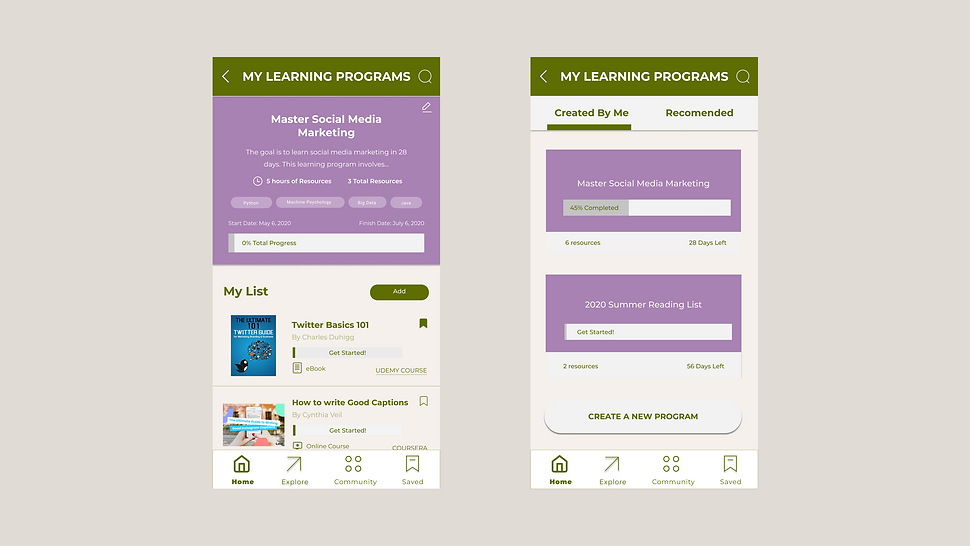.png)
Mid Fidelity Prototype
Please feel free to click through the mid-fidelity prototype:
Reflections
Being flexible and adaptable
The big challenge on this project was switching the last minute in a new design direction. That was combined with harder work to reach the deadline on time with a unique design. At the end of the day, it proved to me the importance of being flexible and adaptable.
Simplicity is strength
My main takeaway was that simplicity is strength. As designers, we are often lured by attractive, trendy, and out of the box designs. But, we must always remember the ‘why’ behind design decisions. The primary goal is to understand the user, their problems, and then come up with a design that solves it.
More rounds of usability testing and iterations are needed to be done
If I had more time working on this project I would do more rounds of usability testing and iteration and then go to a high fidelity design.